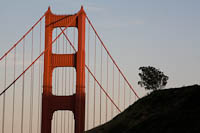June 12, 2006
Quick review: Nikon Coolscan 5000 vs Epson V750-M |
Photo |
|
In the previous post I was observing that scanning slide film on Epson V750-M doesn't live up to the high expectations I had. Scanning some of the Xpan slides produced fairly low quality images that I wasn't satisfied with. So I started out by producing a more rigurous test between the Nikon Coolscan 5000 and the long awaited Epson V750-M. To illustrate the difference between the Nikon Coolscan 5000 film scanner and the Epson V750-M flatbed scanner, I scanned a Schneider SMPTE RP-40 test slide (from Adorama) - click on image to see a larger size: I zoomed on the center portion, which displays a series of lines, very small and hard to discern on a lightbox with a 10x loupe. Here is how the slide appears on the two scanners, with different settings.
Nikon Coolscan 5000, 4000dpi, 16 bit depth, color space grayscale, 1x multiple sample scanning:
Nikon Coolscan 5000, 4000dpi, 16 bit depth, color space grayscale, 4x multiple sample scanning:
Epson V750-M, 4000dpi, 16 bit depth, color space grayscale, mounted slide placed in mounted slide film holder:
Epson V750-M, 6400 dpi, sampled down to 4000dpi, 16 bit depth, color space grayscale, mounted slide placed in mounted slide film holder:
Epson V750-M, 6400 dpi, sampled down to 4000dpi, 16 bit depth, color space grayscale, mounted slide placed directly on the glass surface:
Epson V750-M, 4000dpi, 16 bit depth, color space grayscale, mounted slide placed in mounted slide holder raised 1mm:
As you can see from the images above, the Nikon scanner has a much better contrast, as well as much better resolution. The scanner has a builtin focusing mechanism, which by default is set to automatic, but one can adjust it manually in the software. When set to 4x, Coolscan's multisampling facility provides a much sharper image - this works by scanning the slide 4 times and combining the images. In practice the scanning time increases only slightly. The Epson scanner's high resolution doesn't appear to make any difference in the quality of the image. Several people, including Fazal Majid in a comment on my previous post, suggested scanning with the mounted slide film raised approx 1mm. I did this experiment by placing the slide holder on few paper sheets stacked up to be 1mm in height, as measured with a digital caliper. As you can see from the picture above, this doesn't increase the quality of the picture. Update: Fazal pointed to Vincent Oliver's review and how the tab can be reversed to achieve the same height increase. The obtained scanned image is essentially the same as the one above. In terms of quality there is no doubt in my mind the Coolscan is the clear winner. | |
Hi,
Thanks for doing this test and posting results. Vincent's reviews suggest USM is an essential step in scanning with an Epson, and that Epson scans can withstand much more USM than a dedicated scanner.
Do you think it would be worthwhile to apply some USM to the Epson scan to see how much it might improve?
Thanks,
Greg
Posted by: Greg on June 15, 2006 02:32 AMGreg,
Epson's USM is a software filter, just like Photoshop's unsharp mask filter. The pictures you've seen above have no filter applied to them, they're just crops of the original tiff image generated by the scanner. You can apply Epson's USM filter at the time of the scan, or you can do it in Photoshop after the fact.
In my experience you should never let the scanner apply sharpening for you. It's much better to do it yourself on the raw image afterwards, as you have a lot more control and can experiment with different settings.
As for the effects of the USM on an image, the picture quality cannot be improved by such a filter. Sure, it might look sharper but you won't get any more pixels, an increase in the dynamic range or in the contrast of the image.
I cannot speak for other dedicated film scanners, but based on my experiments, I don't see how the Epson scanner can be better than the Coolscan 5000 when scanning slide film.
Ovidiu
Posted by: Ovidiu on June 15, 2006 03:28 PM| Sun | Mon | Tue | Wed | Thu | Fri | Sat |
|---|---|---|---|---|---|---|
| 1 | 2 | 3 | ||||
| 4 | 5 | 6 | 7 | 8 | 9 | 10 |
| 11 | 12 | 13 | 14 | 15 | 16 | 17 |
| 18 | 19 | 20 | 21 | 22 | 23 | 24 |
| 25 | 26 | 27 | 28 | 29 | 30 |

Apple (44)
Arduino (6)
BeagleBone (1)
Cars (5)
Cocoon (26)
Cool gadgets (14)
Emacs (24)
Google (15)
Hardware (9)
Java (31)
JavaScript (2)
Linux (12)
Music (4)
Open Source (22)
People (2)
Photo (23)
Politics (1)
Random (39)
Travel (4)
Web services (3)
Weblogs (30)
Work (1)
XSLT (12)
January 2015
January 2014
May 2013
June 2011
December 2010
September 2010
August 2010
June 2010
June 2009
May 2009
April 2009
February 2008
November 2007
July 2007
June 2007
May 2007
April 2007
October 2006
August 2006
June 2006
April 2006
March 2006
February 2006
January 2006
December 2005
November 2005
October 2005
September 2005
July 2005
June 2005
April 2005
March 2005
February 2005
October 2004
September 2004
August 2004
June 2004
May 2004
April 2004
March 2004
February 2004
January 2004
December 2003
November 2003
October 2003
September 2003
August 2003
July 2003
June 2003
May 2003
April 2003
March 2003
February 2003
January 2003
December 2002
November 2002
October 2002
September 2002
August 2002
July 2002
June 2002






 Arduino TinyWebServer:
Arduino TinyWebServer: 


